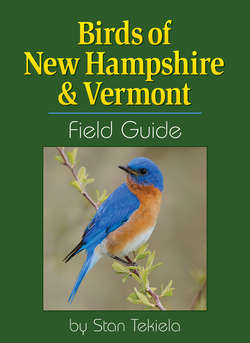Читать книгу Birds of New Hampshire & Vermont Field Guide - Stan Tekiela - Страница 32
На сайте Литреса книга снята с продажи.
Оглавлениеfemale
male
Downy Woodpecker
Picoides pubescens
YEAR-ROUND
| Size: | 6" (15 cm) |
| Male: | A small woodpecker with an all-white belly, black-and-white spotted wings, a black line running through the eyes, a short black bill, a white stripe down the back and red mark on the back of the head. Several small black spots along the sides of white tail. |
| Female: | same as male, but lacks a red mark on head |
| Juvenile: | same as female, some have a red mark near the forehead |
| Nest: | cavity; male and female excavate; 1 brood per year |
| Eggs: | 3-5; white without markings |
| Incubation: | 11-12 days; female and male incubate, female incubates during the day, male at night |
| Fledging: | 20-25 days; male and female feed young |
| Migration: | non-migrator |
| Food: | insects, seeds; visits seed and suet feeders |
| Compare: | Nearly identical to the Hairy Woodpecker, but smaller. Look for the shorter, thinner bill to help identify the Downy. |
Stan’s Notes: Abundant and widespread where trees are present, and perhaps the most common woodpecker in the United States. Stiff tail feathers help brace it like a tripod as it clings to a tree. Like all woodpeckers, it has a long, barbed tongue to pull insects from tiny places. Male and female drum on branches or hollow logs to announce territory, which is rarely larger than 5 acres (2 ha). Male performs most of the brooding. Will winter roost in cavity.
